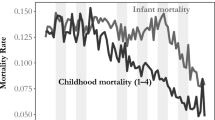Abstract
The relation between fertility and cultural change in a Peruvian Amazon Indian village was studied initially in 1964 and in more detail in 1969. The 1969 study included observations concerning social, economic, environmental, cultural, and health changes. Population growth in the village is nearly 5% per year, and fertility appears to exceed that previously recorded for other groups. The factors that may be contributing to the high fertility are explored. They are thought to include early and prolonged parity, nearly universal marriage and fertility, high reproductive efficiency, short birth intervals, Western health intervention lowering both infant and maternal mortality rates, and a decline in the prevalence of polygyny.
Similar content being viewed by others
References
Agualimpia, C. M., Pabon, A. R., Galan, R. M., Gomez, S. L. C. and Gonzalez, L. E. (1969). Demographic facts of Colombia.Milbank Memorial Fund Quarterly 47: 255–296.
Buck, A. A., Sasaki, T. T., and Anderson, R. I. (1968).Health and Disease in Four Peruvian Villages. Johns Hopkins Press, Baltimore.
Collver, O. A. (1965).Birth Rates in Latin America. University of California, Berkeley.
Dorjahn, V. R. (1958). Fertility, polygyny, and their interrelations in Temne society.American Anthropologist 60: 838–860.
Early, J. D. (1970). Demographic profile of a Maya community.Milbank Memorial Fund Quarterly 48(2): 167–178.
Eaton, J. W., and Mayer, A. J. (1953). The social biology of very high fertility among the Hutterites.Human Biology 25: 206–264.
Hern, W. M. (1976). Knowledge and use of herbal contraceptives in a Peruvian Amazon village.Human Organization 35: 9–19.
Lathrap, D. W. (1968). The “hunting” economies of the tropical forest zone of South America: An attempt at historical perspective. In Lee, R. B., and DeVore, I. (eds.),Man the Hunter. Aldine, Chicago, pp. 23–29.
Lathrap, D. W. (1970).The Upper Amazon, Praeger, New York.
Lorimer, F. (1954).Culture and Human Fertility. UNESCO, Paris, pp. 58–105; 199–206.
Maxwell, N. (1970). Attitudes of four Peruvian jungle tribes towards plants employed as oral contraceptives. Presented at the 39th International Congress of Americanists, Lima, Peru, August 4, 1970 (mimeo).
Nortman, D. (1969).Population and Family Planning Programs: A Factbook.Reports on Population/Family Planning, no. 2. Population Council, New York.
Smith, T. E. (1960). The Cocos-Keeling Islands: A demographic laboratory.Population Studies 14: 94–130.
Vital Statistics of the United States, 1967 (1969). Vol. I —Natality, Section 1, Tables 1-1, 1-2, 1-4, p. 13; Table 1-15, p. 1–15; Vol. II —Mortality, Part A, Section 1, Table 1-1, p. 1–2. U.S. Department of Health, Education and Welfare, Washington, D.C.
Weisbard, S. R. (1957). Indios Shamas de Peru.Ethnographie 53: 19–74.
Whiting, J. W. M. (1964). Effects of climate on certain cultural practices. In Goodenough, W. M. (ed.),Explorations in Current Anthropology. McGraw-Hill, New York.
Author information
Authors and Affiliations
Rights and permissions
About this article
Cite this article
Hern, W.M. High fertility in a Peruvian Amazon Indian village. Hum Ecol 5, 355–368 (1977). https://doi.org/10.1007/BF00889176
Issue Date:
DOI: https://doi.org/10.1007/BF00889176



